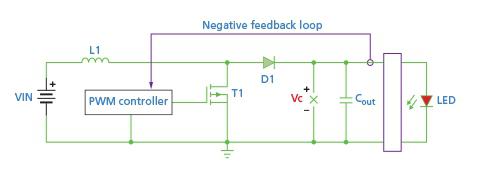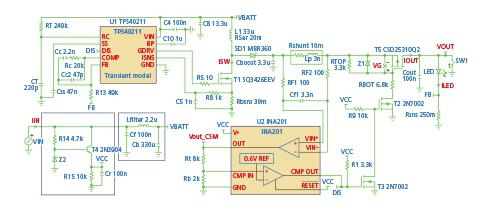In some applications, such as cars Lighting, because the position of the LED is usually far from the driver, it is necessary to increase the short circuit protection. Non-synchronous, boost, and power conversion topologies are typically used In these cases, the input voltage is not sufficient to forward bias a set of series/parallel LED strings. This inductive switching topology generates the constant current output voltage required to achieve LED current regulation and is commonly used in LCD backlight applications. In LED matrix applications, such as automotive interior and exterior lighting, the possibility of a short to ground output due to being away from the driver is real and may even be catastrophic. The protection circuit limits current and acts as an electronic circuit breaker to prevent catastrophic failure. As shown in Figure 1, the input of the boost converter is physically connected to its output through a boost inductor (L1) and a boost diode (D1). Therefore, a short circuit at the output will saturate the boost inductor, causing a current spike that is sufficient to damage the boost diode. To make matters worse, a short circuit can also destroy all connections associated with the input, including a pulse width modulation (PWM) controller. Obviously, some form of circuit protection is required when using this topology to power remote LEDs. We next consider a general-purpose, low-cost circuit that optimizes protection of the boost converter and prevents short-circuit loads at the input. In addition, we will introduce a circuit simulation to verify the required response. Figure 1. Based on a non-isolated boost topology Circuit Current limiter and electronic circuit breaker The Current Shunt Monitor (CSM) is a high precision, high gain differential current sense amplifier that is often used to monitor input and output currents. Figure 2 shows its typical configuration. This particular device integrates an open-drain comparator that can be programmed to trip, latch, and reset on a pre-set line current. Figure 2. Current shunt monitor assembly adds protection The output of this comparator can be used to control an external MOSFET switch that can interrupt a load short circuit in a few microseconds. In addition to interrupting the input current in the event of an output fault, the analog output can be used to address the so-called "negative input impedance" on the switching regulator. When the input voltage is reduced, the “negative input impedance†will cause the input current to increase. Control of the input is achieved by connecting the input current to the output current in a logical configuration. The purpose is to generate a composite feedback signal that drives the PWM controller, as shown in Figure 3. The CSM then covers the output current feedback and forces the LED current to drop to a preset level as the input voltage drops, thereby limiting the input current. Figure 3. Input current limiter relies on sensing input and output current Circuit operation Figure 4 shows the circuit implementation of a boost converter LED driver with output short-circuit protection. Shown in the circuit Opto Semiconductors Ostar LEDs are devices for automotive headlamp applications that are actually a complete five-chip LED on an insulated metal substrate. The device's inrush current rating is 2A, less than 10μs, and a typical 18V forward voltage at 1A. The LED current is set by the sense resistor (RSNS) and its value is proportional to the internal bandgap reference of the PWM converter (RSNS = VREF/ILED). Using a boost converter with a low reference voltage helps achieve higher converter efficiency and reduces component thermal stress. Figure 4. LED boost drive circuit with short-circuit fault protection. Although the LED itself can achieve a lifetime of more than 50,000 hours, LEDs are sensitive to temperature and electrical stress, and the dynamic impedance characteristics of LEDs often challenge the choice of regulator components and the design of the control loop. Therefore, the simulation circuit of Figure 4 was developed to analyze the complexity of the LED driver/protection circuit and predict the circuit characteristics under different operating conditions. The PWM controller selected for this analysis has a feedback reference voltage of 0.26V. Therefore, at an LED current of 1A, only 0.26 W of power dissipation is dissipated in the LED sense resistor. Since the gain of the CSM is 50, a smaller value of the sense resistor is used to sense the output current. When the current through the CSM shunt resistor exceeds the limit set by the CSM sense resistor, the CSM gain and the comparator threshold (R, R), the PMOS channel transistor interrupts the load current, acting as an electronic circuit breaker. The latched output can be reset by switching the RESET pin low. However, for the purposes of this article, RESET has been disabled to check the response speed. The response speed and peak current depend on many variables, including component selection, CSM bandwidth, noise filter, output capacitor, FET selection, and output boost inductor. Together, these factors affect the output impedance of the converter. To accurately evaluate the run, we performed a simulation with a maximum time step set to 50 ns and a DC relative tolerance set to 0.001%. The analysis was performed at TINA-TI, a free Berkeley SPICE 3f5 compatible simulator. The 5 ms analog operation of the boost converter operating at 300 kHz is only started to a steady state within 30 seconds. Where is the current shunt monitor (CSM) placed? The CSM can be placed at the input or output of the boost converter. In this simulation, the CSM is placed at the output to sense the current flowing through the 10-mΩ shunt. The shunt is arranged in series with the output PMOS channel element (T5). Depending on the layout of the CSM, this circuit prevents internal or external short circuits. However, the CSM must be designed to have a sufficient common mode range (CMR) under all operating conditions. If placed at the input of the boost converter, the CSM of the lower CMR can be selected. However, placing the CSM on the output bypasses the boost inductor, which speeds up the short-circuit reaction time. Regardless of where the CSM is placed, an RC filter should be used to reduce the possible noise and resonant ringing of burst di/dt events caused by shunt resistors. A small 100Ω resistor and differential capacitor can be placed with a time constant that is three times the estimated Lp/R time constant of the divider, where Lp is the parasitic shunt inductor. Since the gain error and bandwidth of the CSM are adversely affected by the noise filter, it is necessary to keep the filter value small. Simulation result The simulation results are shown in Figure 5. Vg is the control voltage of the PMOS FET and is set to -6V under normal conditions. Depending on the threshold voltage, valve level charge and saturation characteristics of the FET, optimization is required. Minimizing the voltage of the valve increases the reaction time and should select a pull-up resistor to minimize the interruption period. Note that the input current and threshold voltage are shown as high valve level charge (purple) and low valve level charge (blue) MOSFET. Figure 5. Standard wired and wireless networks will transport relatively simple commands and data passed between physical building systems and building management equipment. It is clear that the lower gate charging device minimizes the current seen at the input. Choosing the MOSFET and gate drive circuit for optimal response is an important consideration, limiting di/dt and meeting the safe operating requirements of the MOSFET. These are complex design considerations that are difficult to analyze; therefore, it is best to perform simulations and validations first. Some oscilloscopes (such as Tektronix products) provide specialized test software to calculate the switching power loss of the MOSFET's safe operating curve. The simulation shows that the response time is less than 2μs and the input current is less than 6A before the current is interrupted. Selecting the interrupt FET will affect the peak input and output current. A high-performance hot-swap controller that drives high-end NMOS devices is another option that can achieve interrupt times of less than 250ns. These devices are optimized for backplane hot card insertion, but may offer a higher performance solution than shown here. Avoid failure In an analog circuit, the input/output current of the boost converter LED driver is interrupted or limited under varying load conditions. This circuit is optimized for use in automotive LED headlamp drivers. Simulations show that achieving optimal circuit response times requires careful analysis and component selection. Integrating these sensitivities into integrated time domain circuit simulations helps to understand the circuit's characteristics for operating conditions and component selection. Specialized hot-swap controllers with specialized features and optimized performance should be considered. In either case, careful analysis is required when implementing circuit interruptions or limiting power supplies. Designing powerful protection circuits for LED drivers is complex and wants to speed up analysis and design. Software like TINA-TI, SPICE, and WEBENCH are useful tools.
Water-cooled capacitor is supercapacitor is a capacitor with a capacity of thousands of farads.According to the principle of capacitor, capacitance depends on the distance between the electrode and electrode surface area, in order to get such a large capacitance, as far as possible to narrow the distance between the super capacitor electrode, electrode surface area increased, therefore, through the theory of electric double layer and porous activated carbon electrode.
Water-Cooled Capacitor,Water-Cooled Power Capacitor,Water-Cooled Electric Heat Capacitor,Water-Cooled Electric Heating Capacitor YANGZHOU POSITIONING TECH CO., LTD. , https://www.cnchipmicro.com




Analysis on Safety Design of Driving Circuit of LED Lighting Attributes in Automobiles
0 times
Window._bd_share_config = { "common": { "bdSnsKey": {}, "bdText": "", "bdMini": "2", "bdMiniList": false, "bdPic": "", "bdStyle": " 0", "bdSize": "24" }, "share": {}, "image": { "viewList": ["qzone", "tsina", "tqq", "renren", "weixin"], "viewText": "Share to:", "viewSize": "16" }, "selectShare": { "bdContainerClass": null, "bdSelectMiniList": ["qzone", "tsina", "tqq", "renren" , "weixin"] } }; with (document) 0[(getElementsByTagName('head')[0] || body).appendChild(createElement('script')).src = 'http://bdimg.share. Baidu.com/static/api/js/share.js?v=89860593.js?cdnversion=' + ~(-new Date() / 36e5)];